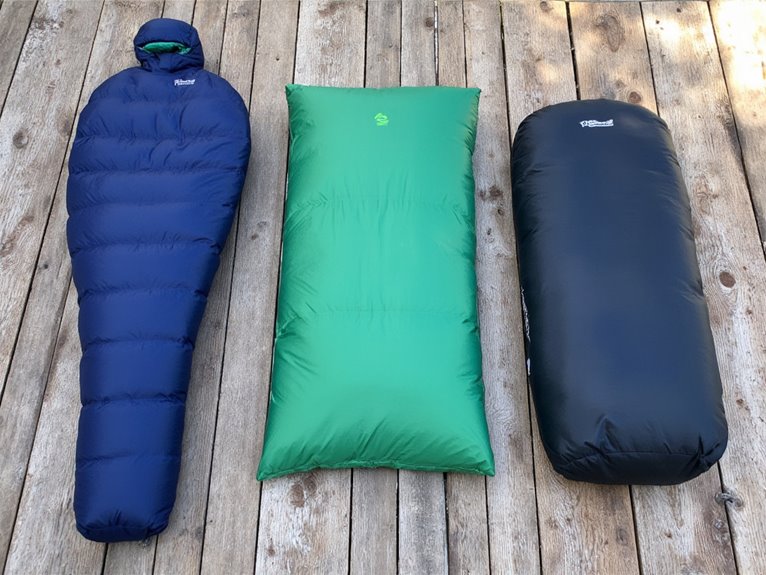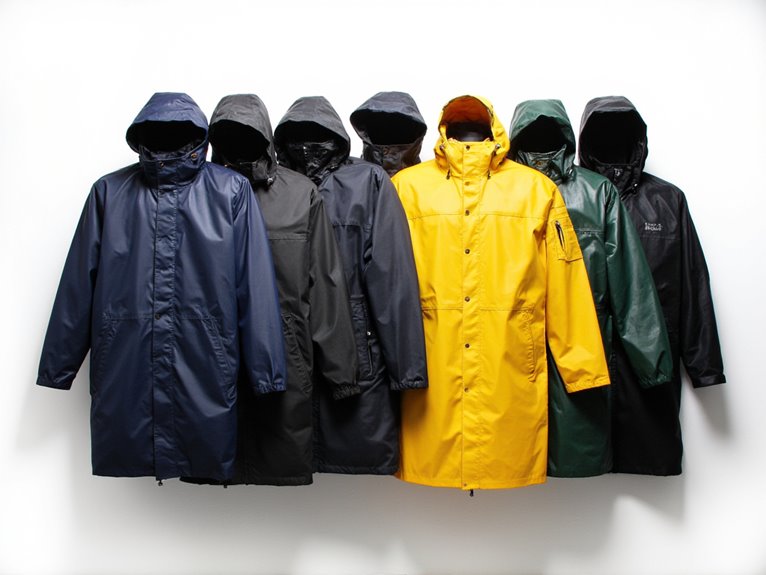Sleeping Bag Shapes: Mummy vs. Rectangular vs. Semi-Rectangular
You’ll find three main sleeping bag shapes that serve different camping needs. Mummy bags offer maximum warmth with their tapered design, rating 10-15% warmer than alternatives while weighing just 1-3 pounds. Rectangular bags prioritize comfort and space but sacrifice thermal efficiency, typically weighing 2-4 pounds with temperature ratings around 20°F minimum. Semi-rectangular designs split the difference, providing moderate space with better heat retention than rectangular options. Your choice depends on whether you prioritize warmth, comfort, or packability for your specific outdoor adventures.
We are supported by our audience. When you purchase through links on our site, we may earn an affiliate commission, at no extra cost for you. Learn more. Last update on 4th December 2025 / Images from Amazon Product Advertising API.
Notable Insights
- Mummy bags are most thermally efficient with tapered design, rated 10-30% warmer than other shapes but offer less interior space.
- Rectangular bags provide maximum comfort and room for movement, ideal for car camping but bulkier and less warm.
- Semi-rectangular bags balance comfort and warmth, tapering at feet while maintaining roomier upper sections for moderate conditions.
- Mummy bags weigh 1-3 pounds and compress smallest, while rectangular bags weigh 2-4 pounds with largest pack size.
- Choose mummy for cold weather backpacking, rectangular for car camping comfort, semi-rectangular for variable seasonal conditions.
Shape Design and Construction Differences
When selecting a sleeping bag, the shape fundamentally determines your comfort level, warmth efficiency, and pack weight for any outdoor adventure.
Mummy bags feature a tapered silhouette that hugs your body from shoulders to feet, reducing internal air space for maximum thermal efficiency. You’ll find narrower dimensions at hips and shoulders, plus an integrated hood that seals heat around your head.
Rectangular bags offer uniform width throughout, providing spacious interiors without movement restrictions. Their design specifics include wider cuts and open head areas, though this increases packed size considerably.
Semi-rectangular models blend both approaches, tapering only at the foot box while maintaining roomier upper sections.
Construction materials and stitching patterns vary between shapes, directly affecting weight, durability, and thermal performance across different outdoor conditions. Rectangular bags offer maximum roominess and include zipper systems that allow two bags to be connected together for shared use during car camping trips.
Thermal Performance and Heat Retention
Beyond the structural differences between sleeping bag shapes lies their most critical performance aspect: thermal efficiency and heat retention capabilities. Mummy bags deliver superior warmth through body-hugging fits that minimize dead air space.
You’ll find these typically rated 10-15% warmer than semi-rectangular designs and up to 30% warmer than rectangular bags using identical insulation types.
Temperature ratings reflect this performance gap dramatically. Mummy bags achieve ratings as low as -40°F, while rectangular bags rarely drop below 20°F comfort ratings. The tapered design and contoured hood create thermal zones that trap your body heat efficiently.
Mummy bags achieve extreme cold ratings down to -40°F while rectangular designs struggle below 20°F through superior heat trapping geometry.
Semi-rectangular bags offer moderate performance, commonly rated between 15-35°F. Your shape choice directly impacts warmth retention—compact mummy designs require less insulation to achieve equivalent temperature ratings compared to roomier alternatives.
Women typically require bags rated 10-15 degrees warmer than standard models regardless of shape, making insulation types and thermal efficiency even more crucial considerations.
Weight and Packability Comparison
As you prioritize gear for extended adventures, weight and packability become decisive factors that directly influence your carrying comfort and overall hiking experience.
Mummy bags excel in both categories, typically weighing 1–3 pounds with superior compressibility due to their tapered design and efficient use of insulation materials.
Weight comparison by shape:
- Mummy bags: 1–3 lbs, most packable design
- Semi-rectangular: 1–2 lbs, moderate pack size
- Rectangular: 2–4 lbs, largest compression footprint
Modern insulation materials greatly impact these metrics. High-end down and synthetic fills reduce bulk while maintaining warmth.
The REI Magma Co-op 30 mummy weighs just 1.5 pounds, demonstrating ultralight capabilities.
Semi-rectangular bags balance space and weight, while rectangular designs sacrifice packability for roominess—making them ideal for car camping where pack size isn’t critical.
Many sleeping bags include compression sacks to further reduce packed size and make transport more convenient for backpackers.
Comfort and Space Considerations
While weight matters for portability, comfort determines whether you’ll actually get a good night’s sleep in the backcountry. Your sleeping preferences directly influence which bag shape works best.
Rectangular bags offer maximum room for stretching and movement, accommodating restless sleepers who toss and turn frequently. Semi-rectangular bags provide balanced comfort with moderate space while maintaining better heat retention than rectangular designs.
Mummy bags prioritize warmth over space, creating a snug fit that some find restrictive. However, side sleepers often adapt well to their contoured shape.
Camping conditions also affect your choice—car camping allows bulkier rectangular bags, while backpacking demands compact mummy designs.
Consider that rectangular bags can unzip completely for comforter-style use, offering versatility in varying temperatures and personal comfort needs. Many mummy-style bags feature spacious footboxes and draft collars to enhance comfort while maintaining their superior heat retention properties.
Best Use Cases for Each Style
Three distinct sleeping bag shapes serve specific camping scenarios and environmental conditions.
Mummy advantages shine in cold weather camping and ultralight backpacking where weight efficiency matters most. Their snug design minimizes heat loss during winter expeditions and mountainous terrain adventures.
Rectangular benefits become apparent during family car camping and summer outings where comfort takes priority over thermal efficiency. You’ll appreciate their roominess for casual camping and multi-person use.
Semi rectangular versatility bridges both worlds effectively. Consider these camping preferences for activity suitability:
- High-activity backpacking: Choose mummy bags for terrain compatibility
- Low-activity car camping: Select rectangular designs for maximum comfort
- Variable conditions: Opt for semi-rectangular styles during shoulder seasons
Your terrain compatibility needs directly influence shape selection, with temperature ranges and weight restrictions determining best performance characteristics. Mummy bags offer superior warmth-to-weight ratios compared to rectangular designs, making them essential for serious backpackers prioritizing pack weight reduction.



